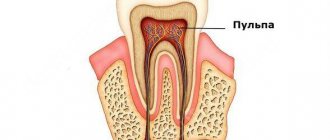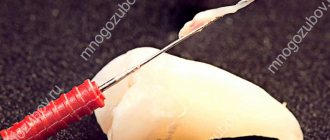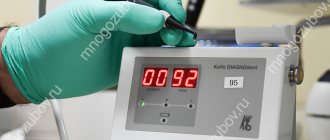Tooth nerve and need for removal
A tooth is not just a bone. In its roots there is a living pulp - blood vessels with nerve endings. This pulp is called the dental nerve; with its help, the tooth senses heat or cold. If the pulp is removed, the tooth dies, is not supplied with blood, is easily destroyed, and is less resistant to influence.
If a tooth is affected by caries, at first the destruction involves only dentin, the durable tissue of the tooth. But if caries is not treated in a timely manner, it will reach the pulp and pulpitis will begin. Then the pulp has to be removed - completely or partially, and if the pulpitis has reached periodontitis, the pulp has to be completely amputated. The nerve is also removed in case of mechanical destruction or prolonged pain.
Question about pain when removing a nerve.
Usually, when it is necessary to remove a nerve, patients succumb to the fear that this is a very painful procedure. But there is no point in worrying! Each qualified specialist in his arsenal has a large number of anesthetics that desensitize the diseased tooth and surrounding tissues. Just one injection, and the person does not feel anything in the area of the diseased tooth.
Local anesthesia is most often used. If the drug is chosen correctly, the entire operation from injection to nerve extraction will be completely painless.
Removal with arsenic
Once upon a time there was only one way to remove it, it was terribly painful, especially since you had to visit the doctor several times. At first, the doctor drilled the tooth down to the pulp with a drill, which was extremely painful. Next, arsenic was placed in the hole and it was temporarily sealed with a filling. In a couple of days, the arsenic dealt with the nerve, and the tooth hurt so much that no medicine could help. Then I had to go to the doctor again, he opened the temporary filling, removed the nerve, and cleaned the root canals. Pulp is a tenacious substance, so this process was also extremely painful.
This technology poses a certain danger, because arsenic is a poison, and the doctor, when using it, must be especially careful, and the patient must be careful: if you are late with the second visit to the doctor and leave arsenic in the tooth, it will completely destroy it, which will end deletion. Dentists stopped using arsenic and developed new techniques for removing pulp.
Will my tooth hurt after pulpitis treatment?
The effect of the anesthetic drug wears off approximately 3 to 4 hours after the injection. The tooth sometimes begins to ache monotonously, and this pain can continue for some time. My tooth made itself felt for about two days. I stopped chewing on the left side of my jaw for several days to avoid getting hard food particles on the filled tooth, because at such moments the pain worsened significantly. These days I measured my body temperature, monitored my well-being, and was wary of complications.
My condition completely stabilized on the fourth day. I got used to the new filling, and the cured tooth stopped hurting. Now all I had to do was carefully monitor the health of my teeth and do everything to prevent deep inflammatory processes that lead to the removal of the nerve.
Surgery to remove a nerve frightens patients more with the unknown than it actually causes pain and discomfort. Toothache tends to be insidious and appear unnoticed, so I recommend everyone not to start inflammatory processes in the oral cavity, consult a dentist in time and not let the matter go to the point of removing the nerve. If indications for removal still appear, feel free to go to a professional and competent doctor. The doctor will select a good anesthetic for you, treat your aching tooth and relieve the pain forever.
Modern pulp removal
Today, it is enough to go to the dentist once to remove the pulp. The doctor gives an anesthetic injection and calmly works with the tooth, removing the destroyed layer of dentin, extracting the pulp, treating and filling the canal. Sometimes inspection using a microscope is possible. To be on the safe side, your doctor may place a filling temporarily to make sure he has completely removed the pulp. And only if everything turns out to be in order, the final filling is installed.
Incomplete removal of the pulp is also possible, which makes sense if only the outer part of the pulp is affected by inflammation. Dead tissue is removed from the opened tooth, the outermost part of the pulp is removed, and the root remains intact. This is especially important on children's teeth, since the pulp is responsible for the formation of roots. When the pulp is not completely removed, the tooth is kept alive, and further destruction occurs more slowly.
How to remove the nerve of a tooth today
Today it has become possible to remove the dental nerve by visiting the dentist just once. Depending on the diagnosis, the nerve is removed completely or partially.
- Complete removal. It is performed under anesthesia. After an anesthetic injection, the doctor removes the affected dental tissue and extracts the pulp with a special tool. The procedure lasts on average half an hour. If the depulpation process was controlled using a microscope, the dental canals and the tooth itself are thoroughly filled after the procedure. Sometimes the dentist first places a temporary filling, and then, after making sure that the procedure was completed successfully, changes it to a permanent one.
- Partial removal. It is carried out when only the coronal part of the pulp is affected. The root is preserved, and the inflamed tissue is removed. If the nerve is partially amputated, tooth decay does not occur as quickly. Therefore, this method is recommended for carious disease of molars in children.
Why does a tooth from which the nerve has been removed hurt?
Patients often complain that the tooth from which the nerve was removed continues to hurt. This is a completely natural pain, the result of intervention in the body. In a couple of days the pain will go away. It can be observed when clenching teeth, when reacting to hot and cold. To reduce discomfort, take analgesic medications.
But if, due to improper treatment, the nerve was not completely removed, the pain and inflammation will return. It is possible that the canals were poorly treated, and there may also be an allergy to the filling material. It is necessary to go to the doctor immediately, since advanced inflammation can lead to tooth loss.
The tooth from which the nerve has been removed becomes dead, but it still remains and is not lost, so if you have a toothache, immediately go to the dentist. There is nothing to be afraid of - modern treatment is painless, and after it your diseased tooth will serve you for many years to come.
Signs of tooth pulpitis
It is divided into acute and chronic phases.
The acute stage of pulpitis is characterized by:
- throbbing, sharp pain;
- External irritants can cause pain: temperature changes, cold or hot food, poor quality dental procedures, touching a sore tooth;
The chronic stage is characterized by:
moderate pain that occurs only with temperature changes, cold, or biting on a sore tooth. Increased tooth sensitivity occurs. Often a fistula also forms, with purulent contents that will periodically come out of the formed hole in the gum.
Other symptoms of the disease: headache, sleep disturbances, fever, loss of appetite.
It happens that the cause of tooth pain can be inflammation of the trigeminal nerve or facial nerve.
Is it possible to kill a nerve yourself?
Many people try to remove the nerve endings in the tooth on their own. When a pathological process develops, the help of a specialist is required, otherwise complications may occur. There are various techniques that show how to kill the nerve of a tooth at home. All of them are for informational purposes only. Vinegar can be used for killing; a piece of cotton wool is treated with vinegar essence and applied to the tooth. It is important to note that the essence can completely destroy enamel and dentin and lead to irreversible consequences.
We looked at what would happen if you removed the nerve in a tooth yourself. This can lead to complete destruction of an element of the dentition. The patient will lose a tooth and may subsequently require the installation of an implant, crown, or other suitable orthodontic structure.
Why does a tooth hurt?
There are no unpleasant sensations during the procedure itself, but there are exceptions. In the case when treatment is carried out without anesthesia, the dental nerve hurts greatly. In dentistry, of course, not pure arsenic is used; the nerve is killed with a multicomponent paste. After the medicine is administered, the organ should not hurt much, since the paste contains an anesthetic substance.
In addition to arsenic, medications contain:
- antiseptic to neutralize pathogenic microflora and disinfect necrosis;
- anesthetic to relieve pain during nerve necrosis;
- an astringent to prolong the action of the paste and slow down the penetration of arsenic into soft tissues.
Representatives of such pastes with arsenic anhydride are Septodent, Kaustinerv, Pulparsen.
What is pulp?
The pulp, or dental nerve, is a bundle of nerve endings and capillaries in the internal cavity of the tooth. It is protected from external irritants and infection by the tissue that is located in the root and crown.
After removal of the nerve, the blood supply and mineralization of the tooth deteriorate significantly. In addition, its sensitivity decreases, the enamel becomes dull and weakens. In other words, pulp removal negatively affects the structure and strength of the tooth, but makes it possible to preserve it.
Indications for the procedure:
- exposure of the nerve as a result of tooth trauma and damage to the crown;
- consequences of improper dental treatment;
- the presence of caries-affected tissues;
- preparation for prosthetics;
- chronic inflammation of the pulp (pulpitis);
- inflammation of the root membrane of the tooth (periodontitis);
- low placement of crowns;
- extensive pulp area;
- bactericidal infection of the apex of the tooth root.
Pain Management Options
The duration of action of a standard anesthetic injection is 45 minutes. Patients who are afraid of injections are offered treatment of the depulpation site with a special paste-like composition of a similar effect. Tablet analgesics may reduce the effectiveness of anesthesia, so dentists do not recommend their use.
The dentist chooses the painkiller, as well as the dosage. Since everyone's pain threshold is different, the dose of anesthetic is often doubled or tripled. If the doctor has administered anesthesia according to the protocol, the patient will not feel any pain or discomfort.
Reviews of doctors providing the service - Tooth nerve removal
I would like to express my gratitude to the dentist Elena Nikolaevna Kiseleva and her assistant Svetlana - they are real specialists and at the same time sensitive, not burnt out by years of practice.
Thanks to them, I have been coming back here for many years. Thanks to the management for such doctors! Read full review Svetlana Nikolaevna
13.08.2021
Words cannot express my gratitude to Elena Nikolaevna Kiseleva. This is the best doctor in the world. I got an appointment after many years of being ignored by the dentist’s office and with a bitter experience of treatment in another paid clinic, the mistakes of which had to be corrected in the first visits. Thank you for this... Read full review
Roman Stanislavovich Sh
25.07.2020
Practical recommendations after visiting the dentist
If depulpation is performed correctly, pain may be observed. The pain may persist for several days. In this case, you can use painkillers prescribed by your dentist. However, if the pain does not stop for a week or more, you should immediately consult a doctor.
In this article, we learned why there are nerve endings in teeth, what important function they perform, and how to act in case of severe pain. In addition, you can learn more about why nerves are needed in teeth on specialized medical web resources, where dentists describe and explain everything in detail.
Alpha Dent specialists provide high-quality dental services. The clinic uses advanced equipment and innovative drugs, which ensures impeccable quality of therapy. Dentists will be happy to tell you how the nerves are located in a person’s teeth and what treatment is needed to achieve the desired result.
Why is it not necessary to remove the nerve to install crowns?
The need to remove the nerve arises primarily when the tooth is completely destroyed. It can also be dictated by the qualifications of the doctor: when heating or deeply removing the top layer, there is a risk of damage to the nerve endings, and this is very painful. That is why many dentists prefer a safer route, that is, preliminary removal of the nerve. Especially in the presence of the initial stage of caries.
In addition, depulpation can be performed in a number of cases before prosthetics: with increased sensitivity, with small sizes and in the presence of more than 15-degree inclination of the teeth. The pulp may also be removed for aesthetic reasons.
It is not necessary to perform depulpation before installing crowns, since the nerve can always be removed through the top of the crown.
After depulpation, the hole is filled. The main disadvantage of this procedure is the exposed tooth root, which can cause complications in the future.
How to kill the pulp in dentistry
A dental procedure is performed under anesthesia, regardless of the nature and scope of the work. The specialist knows why there are nerves in teeth, so he selects an anesthetic taking into account the anatomical features, the patient’s possible allergic reaction and individual wishes. The depulpation process is as follows:
- Removal of dentin and enamel with anesthesia. The procedure is carried out using air cooling technology.
- Placing a special paste that allows you to kill the nerve of the tooth, both the canine and the molar. Today, modern pastes are used to devitalize nerve endings.
- Installation of a temporary filling.
- Removal of temporary filling, opening of the pulp chamber, extraction of nerve endings.
- Canal cleaning, disinfection, filling.
At the final stage, a control x-ray is taken, where the patient and the doctor can see how the canals were sealed. After the procedure, the question may arise about how to relieve toothache even though the nerve has already been removed. For this you can use drugs such as Ibuprofen, Pentalgin, Nimesil. It is recommended to use only those products prescribed by the dentist. After treatment for pulpitis, pain may be observed for a week.











